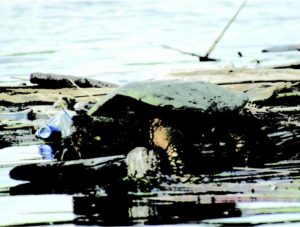To understand the problems facing Lake Hiawatha it is first important to understand how water flows in our community. As part of the Minnehaha Creek Watershed, whatever goes into our storm drains on our streets goes directly into Lake Hiawatha and Minnehaha Creek, which then flows into the Mississippi River. Communities downstream get their drinking water from the Mississippi. The pollution from our streets impacts the drinking water of communities downstream.
Lake Hiawatha is the destination for runoff from the streets of South Minneapolis. The largest of these sub-watersheds drains an area from Lake Street to the north, Chicago Avenue to the west and 28th Avenue South to the east.
Every member of our community should become aware that every scrap of litter and pollution on these streets goes directly into the Lake. There is no filtration system or mitigation to interrupt the flow of debris, litter, and pollution. The remaining majority of South Minneapolis streets empty into Minnehaha Creek upstream of Lake Hiawatha, adding additional pollutants from storm sewer systems upstream all the way up to Lake Minnetonka. I have been removing trash from the Lake since 2015. If you dropped a piece of litter in the past two years, there is a reasonable chance that I, or another volunteer, have picked it up from the shore. There are some pollutants that can’t be picked up. Fertilizers, herbicides, and pesticides applied to our lawns will make their way to the Lake as surely as fungicides currently used on the greens at Hiawatha Golf Course every two weeks.
As part of my cleanup effort at Lake Hiawatha, I started collecting the plastic stakes that hold the signs warning people and pets to stay off lawns sprayed with chemicals. These chemicals impact public health, water quality, and the fragile ecology of our Lake and communities downstream.
I see Lake Hiawatha as a microcosm of the larger global challenges we face. In the Lake is the accumulation of a multitude of little decisions. Every part of our community is represented in the litter I find, crossing all socio-economic and ethnic backgrounds. You can see the accumulation of these decisions in the form of plastic and styrofoam trash, cigarette butts, etc. What we can’t see is the chemical residue that we add to our water when we decide to treat our lawns.
I could find no test results for pesticides and herbicides at Lake Hiawatha. This is not necessarily reassuring. I did however find results for Minnehaha Creek and a few metro lakes. A USDA study of pesticides in Minnesota found significant levels of the herbicide triclopyr in Minnehaha Creek. One can reasonably assume that if it was found in the Creek, it was in Lake Hiawatha.
Triclopyr is the active ingredient in ‘Weed B Gone’ and myriad other products. It is toxic to humans, wildlife and ecological function. Triclopyr has been used for years by lakeshore property owners to treat milfoil at Lake Minnetonka. The use of glyphosate (Roundup, etc.) has skyrocketed in recent years. With 25 million pounds sold annually in Minnesota. Herbicides 2, 4-D and atrazine were also detected in tests conducted at Lake Nokomis and Lake Harriet.
The omnipresence of herbicides in our lives is troubling. They are detected in our water, our soil, our food, our bodies and even in the clouds and rain. We don’t consider the cumulative and synergistic effects of these chemicals on our bodies and the environment. If you add up the exposure from so many sources, it is no stretch to imagine them impacting our health and ecology.
Lake Hiawatha is blessed and cursed by the amount of water that flows through it from the storm sewer, golf course pumping, and Minnehaha Creek. All three sources likely carry levels of herbicides and pesticides into the Lake and beyond. The Lake is blessed in that it is rapidly refreshed by the constant flow of water.
Don’t lose hope for Lake Hiawatha—despite the environmental challenges, it remains a beautiful place and home to a diversity of wildlife.
I am convinced that change is coming to Lake Hiawatha. I’m hopeful that the parks and city will mitigate the major storm sewer outfall that currently dumps into the Lake directly, stopping the flow of trash. I’m hopeful that the watershed district might re-meander the Creek, creating additional curves to slow the water and increase filtration. Re-meandering the Creek, not diverting the Creek into a new location, is critical to limit the arrival of sediment into the Lake, restore the wetlands, and protect existing habitat.
Lastly, each of us as neighbors of the Lake, can help support increased water quality and ecology by stopping our use of lawn chemicals and pesticides.
























Thank you for this article! People can address their lawn and garden challenges in much safer ways. Here is a link to help folks do just that: https://www.gardengreen.org/green-ways-that-work
Thank you so much for your work and this great article. I’m sharing it on Facebook Pollinator Friendly Yards.
Excellent article! Should be a must read for everyone in the community to understand the relationship between chemicals, ecology and human health